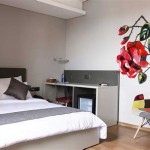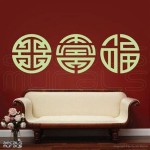Unlocking the Elegance: A Guide to Chinese Room Decor
Chinese room decor is a multifaceted art form that draws upon centuries of history, philosophy, and artistic expression. It's more than just a style; it's a way of life encapsulated within the four walls of a room. Embracing Chinese interior design principles involves understanding the symbolism behind the colors, materials, and arrangements used. The goal is not merely to create a visually appealing space but also to curate an environment that promotes harmony, balance, and tranquility.
Historically, Chinese interiors have been meticulously planned, reflecting the social hierarchy and the occupants’ personal beliefs. The layout, the selection of furniture, and the placement of decorative objects were all carefully considered. While modern interpretations may offer more flexibility and adapt to contemporary lifestyles, the fundamental principles remain relevant, providing a framework for creating elegant and culturally rich spaces.
Key Principles of Chinese Room Decor
Several key principles underpin Chinese room decor, influencing the overall aesthetic and atmosphere of a space. These principles, often intertwined with philosophical concepts like Feng Shui, guide the selection and arrangement of elements within the room.
Balance and Harmony (Yin and Yang): The concept of Yin and Yang is fundamental to Chinese philosophy and deeply influences interior design. Achieving balance involves carefully considering opposing elements. For example, dark and light colors, smooth and rough textures, and solid and void spaces should be thoughtfully integrated. The goal is to create a sense of equilibrium, preventing the room from feeling chaotic or stagnant. This balance promotes a feeling of well-being and allows energy (Qi) to flow freely through the space.
Feng Shui Considerations: Feng Shui, which literally translates to "wind and water," is an ancient Chinese practice that focuses on arranging living spaces to optimize the flow of Qi. This involves considering the orientation of the room, the placement of furniture, and the use of specific colors and materials. For instance, the placement of beds and desks is often dictated by Feng Shui principles to promote restful sleep and productive work. Mirrors are strategically placed to enhance positive energy and expand the perceived space. While a complete Feng Shui overhaul may require professional consultation, incorporating basic principles can significantly improve the ambiance of a room.
The Importance of Natural Elements: Chinese room decor frequently incorporates natural elements to connect the occupants with the outdoors. Wood, bamboo, stone, and water features are commonly used to bring a sense of organic beauty into the space. Houseplants, particularly those with symbolic significance like orchids and lucky bamboo, are often incorporated to purify the air and add a touch of vitality. Natural light is also highly valued, and windows are often left unadorned or covered with light, translucent fabrics to maximize its presence.
Essential Elements of Chinese Room Decor
Beyond the guiding principles, specific elements contribute significantly to the characteristic aesthetic of Chinese interior design. These elements range from furniture styles to color palettes and decorative accessories.
Furniture: Traditional Chinese furniture is characterized by its elegant lines, intricate carvings, and use of dark woods like rosewood or ebony. Characteristically, furniture is frequently finished with lacquer which provides a durable and beautiful surface. While authentic antique pieces can be costly, modern reproductions offer a more accessible way to incorporate this style. Key furniture pieces include low-slung sofas, ornate screens, and lacquered cabinets. The furniture should be arranged to promote conversation and flow, avoiding clutter and creating a sense of spaciousness.
Color Palette: The color palette in Chinese room decor is rich in symbolism. Red, representing good fortune and prosperity, is a prominent color often used sparingly as an accent. Gold symbolizes wealth and power, while yellow represents royalty and is associated with the emperor. Blue and green represent growth and harmony, while black is associated with water and represents depth. The use of color should be purposeful and balanced, avoiding excessive use of any single color. Often, a neutral base is used, with carefully selected accent colors to create visual interest without overwhelming the space.
Decorative Accessories: Accessories play a crucial role in adding character and personality to a Chinese room. Porcelain vases, silk paintings, calligraphy scrolls, and jade sculptures are common decorative items. These objects often carry symbolic meanings, further enriching the cultural significance of the space. The placement of these accessories is carefully considered to create focal points and draw the eye throughout the room. Grouping similar objects together can create a more impactful display than scattering them randomly. Plants like bonsai trees or orchids can add a touch of nature and tranquility.
Bringing Chinese Decor into Modern Homes
Integrating Chinese room decor into modern homes requires careful consideration and a balanced approach. It's important to avoid creating a space that feels like a museum or a themed room. The key is to incorporate elements of Chinese design in a way that complements the existing architecture and personal style.
Blending Styles: A successful integration often involves blending Chinese elements with other design styles, such as minimalist or Scandinavian. This can be achieved by incorporating a few key pieces of Chinese furniture or artwork into a relatively simple and modern space. The contrast between the traditional and contemporary elements can be striking and create a unique and sophisticated look. It is important to pick a cohesive color palette that ties the various elements together to ensure the space feels harmonious rather than disjointed.
Adapting to Space Constraints: Chinese furniture can sometimes be bulky, which may not be suitable for smaller apartments or homes. In such cases, it's important to choose smaller pieces or opt for modern interpretations of traditional designs. For example, a smaller lacquered cabinet can serve as a stylish storage solution, while a simple bamboo screen can be used to create a sense of privacy and division. Consider using lighter colors and reflective surfaces to maximize the perceived space.
Focusing on Key Elements: When space or budget is limited, the best approach is to focus on incorporating a few key elements that capture the essence of Chinese room decor. This could involve adding a striking piece of artwork, incorporating a symbolic plant, or using fabrics with traditional Chinese patterns. Even small details, such as using Chinese-inspired hardware or incorporating a tea ceremony set, can contribute to the overall aesthetic. The focus should be on quality rather than quantity, selecting pieces that are meaningful and well-crafted.
Ultimately, creating a Chinese-inspired room is an exercise in thoughtful design and cultural appreciation. By understanding the underlying principles and carefully selecting the right elements, one can create a space that is not only beautiful but also imbued with a sense of tranquility, balance, and cultural significance.

20 Chinese Home Decoration In The Living Room Design Lover Asian Rooms Japanese Decor Best

Chinese Culture And Traditional Decorating Interior Interact China Living Room Asian Decor

Pin On Home Inspo

Top 5 Asian Living Room Design Ideas You Ll Love Designcafe

20 Chinese Home Decoration In The Bedroom Design Lover Asian Decor

Add Asian Style To Bedroom Decor Tips And Tricks The Architects Diary

6 Festive Home Decor Ideas For Chinese New Year 2025

20 Chinese Home Decoration In The Living Room Design Lover Red Sofa Inspiration Colourful

Chinese New Year Decorating For The Of Monkey

Asian Inspired Bedrooms Design Ideas S







